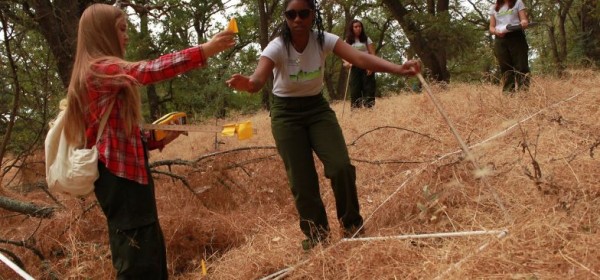[photo] Nature Conservancy interns work to pinpoint the coordinates of native plant plots with compasses, GPS and tape measures.

AS FEATURED IN SAN FRANCISCO CHRONICLE
By Tom Stienstra
Published: July 19, 2014
Photo Credit: Nancy Crowley/Nature Conservancy
At dusk on the Cosumnes River last week, a group of teenagers paddled their canoes under a bridge and then heard some squeaks and flaps above them. Curious, the paddlers looked up, and in the next few minutes, witnessed the fly-out of clouds of bats as they emerged for their night flights.
“I couldn’t believe it; I’d never seen a bat before,” said Ariane Buckenmeyer, 17, one of the paddlers. “What looked like tens of thousands of them were right above us. We were all bewildered, to be honest, yet it was incredible. We didn’t know you could see such a thing. We were speechless, in our canoes, staring at all the bats in the sky.”
The bats darted about as they used echolocation, where they bounce ultrasonic sound waves off flying insects, to track their prey. A dusk fly-out is one of the great spectacles of summer. This group of paddlers had a perfect view as part of a nature-based program for youths.
Buckenmeyer is one of 150 students, mostly young women in high school, who are taking part in an outdoors science and recreation program this summer in 27 states, sponsored by the Nature Conservancy. It is called “LEAF,” which stands for “Leaders in Environmental Action for the Future.” In its 20th year, about 700 young people have completed the program and more than 30 percent of those have gone on to pursue environmental careers.
The program merges outdoors fun with science and conservation fieldwork. This past week, for instance, the LEAF students kayaked to Fannette Island in Emerald Bay at Lake Tahoe and then canoed the Cosumnes River near Galt in the San Joaquin Valley. In the process, they also checked Lake Tahoe’s water clarity, removed invasive plants from the Cosumnes River Preserve, surveyed and plotted native plant distribution, and amid drought, examined the health of the nearby Castello Forest. They also visited several colleges, including UC Davis and UC Santa Cruz.
This week, they’ll head to the Dye Creek Preserve east of Red Bluff – the land of Ishi, once known as California’s “last wild Indian” – to explore American Indian sites in canyons that include acorn bedrock mortars in cave hollows. Then they’ll head to the High Sierra and Independence Lake and its feeder streams to kayak, camp and explore the protected habitat of the rare Lahontan cutthroat trout.
“I grew up in the city,” Buckenmeyer said. “I haven’t traveled much. A lot of us don’t know about wildlife outside of the city or what was here before (it was settled). In high school, there hasn’t been much of an emphasis on the environmental sciences.
“My first time camping was last fall,” she said. “It was eye-opening. It was incredible. I’ve never had so much fun. I found out I love backpacking, the wild environment, with no sight of human civilization. We had to get used to the idea of hearing the coyotes howling at night. And there were so many stars. We just stared at all the stars.”
The Nature Conservancy, a non-political organization that buys and protects unique habitats and then provides leave-no-trace public access to them, pays for the group’s overhead.
[photo] Ariane Buckenmeyer, 17, examines skull and scapula of a wild goat found in foothills at Cosumnes River Preserve — she will later examine jaw and teeth for age and health.
The outdoor experience has had a big effect on her view of the world, Buckenmeyer said.
“We have responsibilities as humans,” she said. “There are beautiful environments that are slowly being destroyed. We need to promote environmental advocacy.”
One way to do that, says Brigitte Griswold, the Nature Conservancy’s director of youth programs, is to improve environmental and outdoor education.
The LEAF program could be a template for schools across America – especially for young women, who are under-represented in science fields.
“We try to provide that ‘aha moment,’ where a young person experiences something they haven’t seen before or even imagined” to get them hooked, Griswold said.
“There’s very few women in the science fields” – known as “STEM” (science, technology, engineering, math) – she said.
“We’re trying to expose young people to careers in natural sciences before they decide their colleges,” Griswold said. “We can’t wait until they get to college. Four out of five STEM students decide their majors in high school or earlier.”
In addition, jobs in environmental science are expected to grow by 25 percent in the next two years, the fastest among any field of science, Griswold said.
Preparing for her senior year of high school, Buckenmeyer is a testament to the program: a bright young woman, with a zest for life and an engaging natural curiosity for all things in nature, who will decide her life’s course, college and field of study in the coming year. Right now she’s leaning toward becoming a wildlife biologist.
She has her hobbies, of course – “I like playing my guitar, a Stratocaster,” she said – and after being exposed to nature, she finds herself drawn back, out of the city, over and over.
“I love going down to the tide pools,” she said, “I go every chance I get.”
For more information, go to www.nature.org/leaf.
National youth survey
Key findings from the National Survey on Youth and Nature, funded by the Nature Conservancy, the Toyota USA Foundation and the Foundation for Youth Investment:
Computer time: 88 percent of American youths say they spend time online every day.
TV/video games: 69 percent play video games or watch TV with the same level of frequency.
Homework: More than half of American youths, 58 percent, spend more time on the computer, playing video games or watching TV than they do on homework or studying for school.
Outdoors: Fewer than 40 percent of American youths participate in hiking, fishing, hunting or visiting a park, beach or natural area once a week.
Nature rating: 51 percent rate the condition of nature as a “very serious” problem.
Who’s to blame? 73 percent of youths say previous generations have damaged the environment and left the problems for them to fix.
Rating the government: Only 33 percent believe that government is doing a good job addressing problems that face our country.
Outdoor education: 66 percent of youths say they have had a personal experience in nature that made them appreciate it more.
Making a connection: Those who have had a special experience in nature are twice as likely to spend time outdoors, significantly more likely to express concern about the condition of the environment, twice as likely to strongly agree that protecting the environment is “cool,” and substantially more likely to study the environment in college.
Tom Stienstra is The Chronicle’s outdoors writer. He will present the show “Sierra Crossing” at 7 p.m. Tuesday at REI-San Francisco.
E-mail: tstienstra@sfchronicle.com Twitter: @StienstraTom
[royalslider id=”21″]








